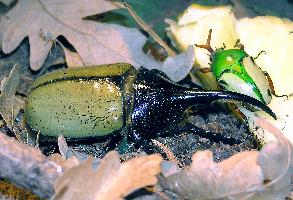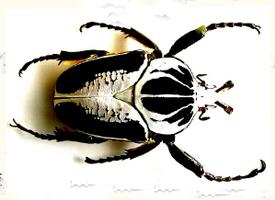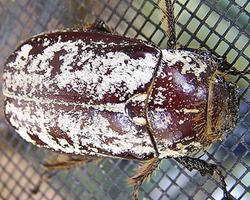
Greutăți și măsuri
| Lungime | de la 55 la 180 mm |
|---|
Descrierea animalului
The Hercules beetle (Dynastes hercules) is one of the most remarkable and fascinating insects in the animal kingdom, renowned for its incredible strength and unique physical attributes. This species belongs to the Scarabaeidae family, which is known for comprising some of the largest beetles in the world. The Hercules beetle is predominantly found in the rainforests of Central and South America, thriving in environments that are humid and rich in vegetation.One of the most striking features of the Hercules beetle is its size. It is one of the largest of all beetles, with males reaching lengths of up to 17 centimeters (6.7 inches) including their horn, making them not only the largest species within the genus Dynastes but also one of the largest flying insects in the world. Females are smaller, generally lacking the prominent horn and having a more uniform body size that does not exceed 13 centimeters (5.1 inches).
The body of the Hercules beetle is divided into three main parts: the head, thorax, and abdomen, typical of insects. The coloration of their exoskeleton can vary remarkably; it usually ranges from a deep black to a greenish, gray, or even a golden hue, with the possibility of a spotted or mottled pattern. The male Hercules beetles are particularly known for their impressive, forward-projecting horns, which are used in combat with other males over territory or mates. These horns, which resemble those of a rhinoceros, can be almost as long as the beetle's body itself, and their size is often a good indicator of the beetle's overall health and nutrition during its larval stage.
The life cycle of the Hercules beetle is as fascinating as its appearance. It goes through complete metamorphosis, starting from an egg to a larva, then pupating into a pupa, and finally emerging as an adult. The larval stage can last up to two years, during which the larva feeds voraciously on decaying wood and plant matter, growing to a substantial size before pupating. This growth period is crucial for the development of the beetle, especially for the males, as the size and health of the larva directly influence the size of the horns and the body.
Hercules beetles are nocturnal creatures, primarily active during the night when they venture out to feed on tree sap and fruit. Despite their formidable appearance, they are harmless to humans and are not known to bite or sting. In fact, their impressive strength, which allows them to carry up to 850 times their body weight, is primarily used for burrowing and moving through their dense, forested habitats rather than aggression.
In many cultures, the Hercules beetle is admired for its strength and beauty, often being sought after by collectors and entomologists. However, like many species that inhabit the world's rainforests, they face threats from habitat destruction and climate change. Conservation efforts are crucial to ensure that these incredible insects continue to thrive in their natural environments for generations to come.
In summary, the Hercules beetle is an extraordinary insect, notable for its size, strength, and unique appearance. It is a marvel of the natural world, embodying the incredible diversity and complexity of life on Earth.
Animale similare
Fotografii noi cu animale
Top 10 animale
- Dolphin gull (Leucophaeus scoresbii)
- Diana monkey (Cercopithecus diana)
- Moustached guenon (Cercopithecus cephus)
- Galápagos tortoise (Geochelone nigra complex)
- Stone loach (Barbatula barbatula)
- Japanese macaque (Macaca fuscata)
- Greek tortoise (Testudo graeca)
- Russian tortoise (Testudo horsfieldii)
- Common flying dragon (Draco volans)
- Galápagos penguin (Spheniscus mendiculus)


